Who Controls the User Experience? AMD’s Carrizo Thoroughly Tested
by Ian Cutress on February 4, 2016 8:00 AM ESTBenchmark Results: Web and Synthetic
Here are our results from our web and synthetic tests. A reminder of our systems:
| System Overview | |||||
| µArch | APU | Base / Turbo MHz |
Memory | Channel | |
| HP Elitebook 745 G2 | Kaveri | A10 PRO-7350B (19W) | 2100 / 3300 | 8 GB | Dual |
| HP Elitebook 745 G3 | Carrizo | PRO A12-8800B (15W) | 2100 / 3400 | 4 GB | Single |
| Toshiba Satellite E45DW-C4210 |
Carrizo | FX-8800P (15W) | 2100 / 3400 | 8 GB | Single |
| HP Pavilion 17z-g100 |
Carrizo | A10-8700P (15W) | 1800 / 3200 | 8 GB | Single |
| Lenovo Y700 | Carrizo | FX-8800P (15W) | 2100 / 3400 | 16 GB | Single |
Google Octane 2.0
Lots of factors go into web development, including the tools used and the browser those tools play in. One of the common and widely used benchmarks to judge performance is Google Octane, now in version 2.0. To quote: 'The updated Octane 2.0 benchmark includes four new tests to measure new aspects of JavaScript performance, including garbage collection / compiler latency and asm.js-style JavaScript performance.' We run the test six times and take an average of the scores.
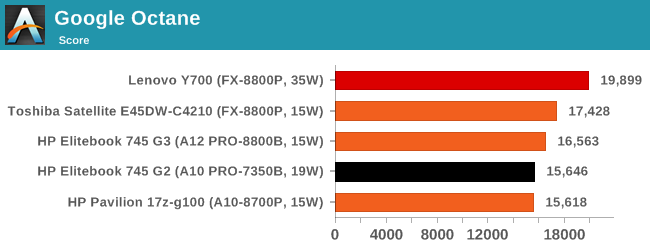
Octane splits hairs between the Kaveri and A10-8700P, but the Toshiba has the higher skin temperature and can turbo for longer than the Elitebook G3.
Mozilla Kraken 1.1
Kraken is a similar tool to Google, focusing on web tools and processing power. Kraken's tools include searching algorithms, audio processing, image filtering, flexible database parsing, and cryptographic routines.
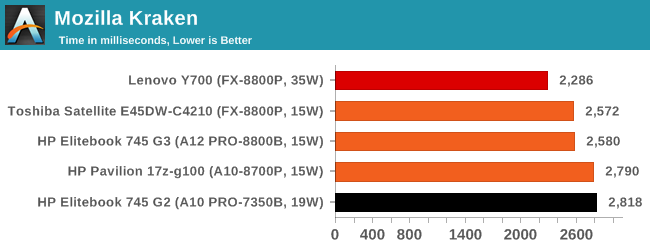
Kraken mirrors Octane, except this time the A10-8700P gets a jump on the Kaveri.
WebXPRT 2013/2015
WebXPRT aims to be a souped up version of Octane and Kraken, using these tools in real time to display data in photograph enhancement, sorting, stock options, local storage manipulation, graphical enterfaces and even filtering algorithms on scientific datasets. We run the 2013 and 2015 versions of the benchmark.
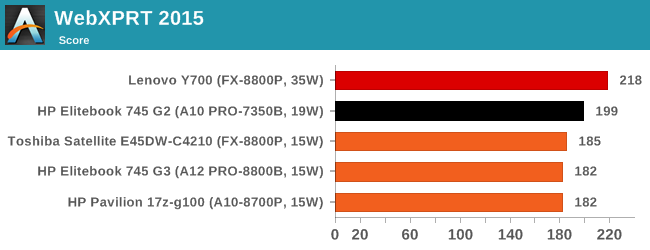
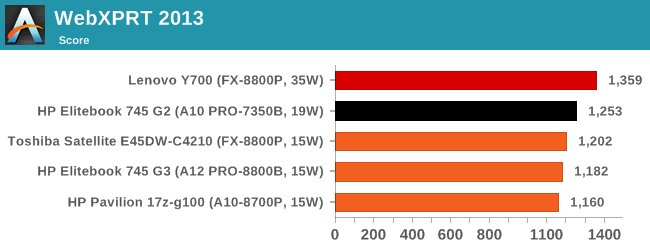
In both versions of the benchmark, the Kaveri system beats all the 15W Carrizo platforms. It was inevitable that at some point during the benchmarking that those extra four watts of thermal headroom in the chip might allow the CPU to turbo for longer – as WebXPRT is by nature a bursty workload, if it can use this to its advantage then we’ll surely see a regression.
I want to pull out some power numbers a little early here to show what I mean. Here are the two Elitebooks in WebXPRT 2013, whose scores differ by 6%:
These power numbers were taken under the ‘all else equal rule’, so each screen was at the same brightness and almost zero applications requesting run time in the background. Here we see that the Carrizo system is drawing less power on average in idle and load (a common theme), but suffers from higher peak power draw and a much larger average-to-idle change in power (which can be overshadowed by onboard components coming out of sleep). It means we get the very uneasy metric of 1208.7 J of energy consumed for the Kaveri over idle and 1932.8 J of energy consumed for Carrizo, though it does depend on how much idle is truly idle across the whole SoC and platform.
This might be where the performance deficit lies though – in a Carrizo system that boasts lower power at idle and lower power draw on average, in a bursty workload environment it is actually wasting time and power to switch things on and off constantly.
Cinebench 15/11.5
Cinebench is a widely known benchmarking tool for measuring performance relative to MAXON's animation software Cinema 4D. Cinebench has been optimized over a decade and focuses on purely CPU horsepower, meaning if there is a discrepancy in pure throughput characteristics, Cinebench is likely to show that discrepancy. Arguably other software doesn't make use of all the tools available, so the real world relevance might purely be academic, but given our large database of data for Cinebench it seems difficult to ignore a small five minute test. We run the modern version 15 in this test, as well as the older 11.5 due to our back data.
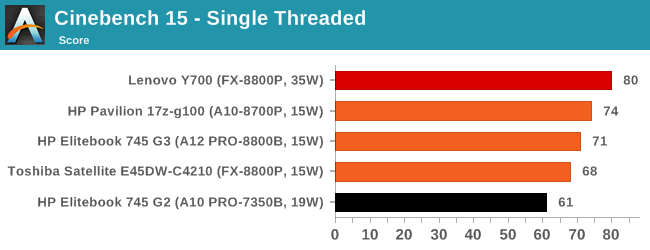

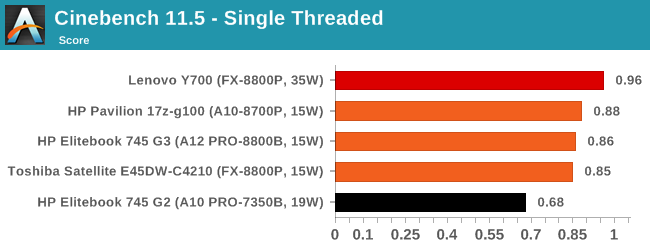
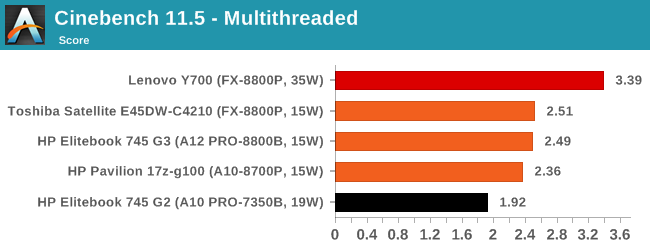
Cinebench shows the spread of performance relating to the microarchitecture advantages of Carrizo compared to Kaveri, as well as the benefits that a 35W part can give over a 15W part. That being said, this spread of results, while perhaps an academic answer to ‘which is the fastest’ is not often seen in the real world.
x264 HD 3.0
The x264 HD 3.0 package we use here is also kept for historic regressional data. The latest version is 5.0.1, and encodes a 1080p video clip into a high quality x264 file. Version 3.0 only performs the same test on a 720p file, and in most circumstances hits its limit on high end processors, but still works well for mainstream and low-end. Also, this version only takes a few minutes, whereas the latest can take over 90 minutes to run.
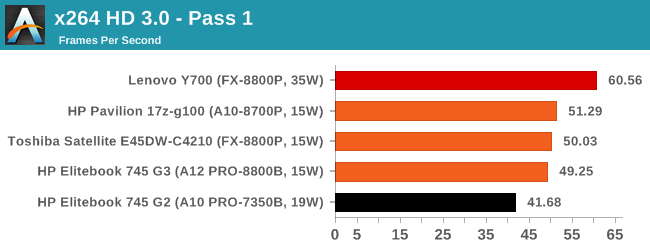
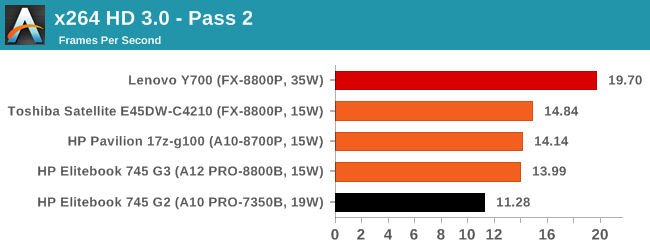
As with Cinebench, we get an ideal academic spread of data.






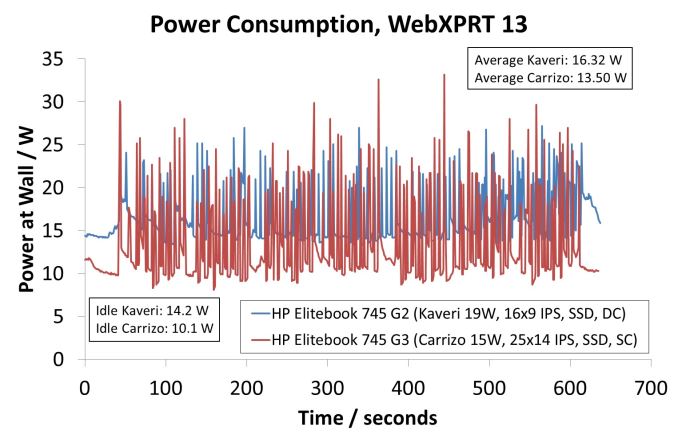








175 Comments
View All Comments
basicmath - Saturday, February 6, 2016 - link
can you post a link to those dual channel benchies please :)basicmath - Saturday, February 6, 2016 - link
actually just saw the notebook check graph, that is a considerable increase in performance!zodiacfml - Sunday, February 7, 2016 - link
Right! The review should have included dual channel performance. Going through the review, I thought Intel finally came close with AMD in graphics performance. With dual channel, Carrizo is well ahead in gaming benchmarks at nearly half the price.extide - Thursday, March 24, 2016 - link
AMD does not have a partnership with Samsung. GF does, but GF is, now, a separate company.Gc - Saturday, February 6, 2016 - link
Anandtech: how did you determine that the Y700 pre-production unit that you tested was accessing its two memory cards through a single channel only? Are you simply reporting what AMD told you, or is there a test that readers can use to check production laptops, and other machines? (Might the two memory cards be mismatched in some way, so the processor backed off to single channel mode?)typo:
s/ R9 385MX / R9 M385X /
Ian Cutress - Saturday, February 6, 2016 - link
Aside from being told directly, I did memory bandwidth testing and other software indicators (CPU-Z, AIDA, etc). Both modules were matched, I took them out and had a look.basicmath - Saturday, February 6, 2016 - link
@Ian Cutress, any reason you didn't put an extra 4GB stick in the G3 745? Seems like a really simple thing to do and would have given a really useful graphical comparison. I guess you guys are too poor to have a stick floating around!Ian Cutress - Saturday, February 6, 2016 - link
Aside from your snarky comment, your answers are explained in the review.The laptops were tested as sold. This is a review on the user experience of these devices. As shown on the Carrizo vs Core page, device after device from Carrizo comes by default with a single stick of memory. Most users who pick a device and go don't want to understand why their UX is the way it is, it just needs to work when they buy it.
I'd also like to mention that testing five laptops with a our suite of tests plus power testing and thermal testing in a single week without an opportunity to revisit is mightily tough for one person who doesn't have access to all their normal gear (testing was done on location, as mentioned), and adding in more variables extrapolates testing time which I didn't have.
We'll be doing further testing for Carrizo, specifically on generational updates, when the Athlon X4 845 comes out. I'm hoping to rope in an R-Series Carrizo platform as well (with IGP) to test DDR3/DDR4 comparison points.
basicmath - Saturday, February 6, 2016 - link
Dude, you highlighted the fact that the 512 core Carrizo chip was running on a single channel, weren't you even slightly curious to find out how it performed on dual channel? It's like reviewing a water proof phone and not trying to drown it!erple2 - Sunday, February 7, 2016 - link
No, its like testing a phone as it came from the factory, then not paying for some third party "waterproofing" company to waterproof the phone and testing it underwater.